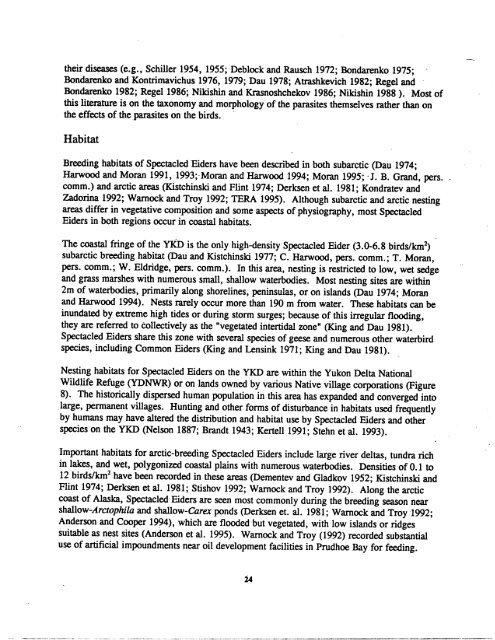A. Status of the Spectacled Eider - U.S. Fish and Wildlife Service
A. Status of the Spectacled Eider - U.S. Fish and Wildlife Service
A. Status of the Spectacled Eider - U.S. Fish and Wildlife Service
Create successful ePaper yourself
Turn your PDF publications into a flip-book with our unique Google optimized e-Paper software.
<strong>the</strong>ir diseases (e.g., Schiller 1954, 1955; Deblock <strong>and</strong> Rauseb 1972; Bondarenko 1975;<br />
Bondarenko <strong>and</strong> Kontrimavichus 1976, 1979; Dau 1978; Atrashkevich 1982; Regel <strong>and</strong><br />
Bondarenko 1982; Regel 1986; Nikishin <strong>and</strong> Krasnoshchekov 1986; Nikishin 1988). Most <strong>of</strong><br />
this literature is on <strong>the</strong> taxonomy <strong>and</strong> morphology <strong>of</strong><strong>the</strong> parasites <strong>the</strong>mselves ra<strong>the</strong>r than on<br />
<strong>the</strong> effects <strong>of</strong> <strong>the</strong> parasites on <strong>the</strong> birds.<br />
Habitat<br />
Breeding habitats <strong>of</strong> <strong>Spectacled</strong> <strong>Eider</strong>s have been described in both subarctic (Dau 1974;<br />
Harwood <strong>and</strong> Moran 1991, 1993; Moran <strong>and</strong> Harwood 1994; Moran 1995; J. B. Gr<strong>and</strong>, pers.<br />
comm.) <strong>and</strong> arctic areas (Kistchinski <strong>and</strong> Flint 1974; Derksen et al. 1981; Kondratev <strong>and</strong><br />
Zadorina 1992; Warnock <strong>and</strong> Troy 1992; TERA 1995). Although subarctic <strong>and</strong> arctic nesting<br />
areas differ in vegetative composition <strong>and</strong> some aspects <strong>of</strong> physiography, most <strong>Spectacled</strong><br />
<strong>Eider</strong>s in both regions occur in coastal habitats.<br />
The coastal fringe <strong>of</strong> <strong>the</strong> YKD is <strong>the</strong> only high-density <strong>Spectacled</strong> <strong>Eider</strong> (3.0-6.8 birds/km 2)<br />
subarctic breeding habitat (Dau <strong>and</strong> Kistchinski 1977; C. Harwood, pers. comm.; T. Moran,<br />
pers. comm.; W. Eldridge, pers. comm.). In this area, nesting is restricted to low, wet sedge<br />
<strong>and</strong> grass marshes with numerous small, shallow waterbodies. Most nesting sites are within<br />
2m <strong>of</strong> waterbodies, primarily along shorelines, peninsulas, or on isl<strong>and</strong>s (Dau 1974; Moran<br />
<strong>and</strong> Harwood 1994). Nests rarely occur more than 190 m from water. These habitats can be<br />
inundated by extreme high tides or during storm surges; because <strong>of</strong> this irregular flooding,<br />
<strong>the</strong>y are referred to collectively as <strong>the</strong> “vegetated intertidal zone” (King <strong>and</strong> Dau 1981).<br />
<strong>Spectacled</strong> <strong>Eider</strong>s share this zone with several species <strong>of</strong> geese <strong>and</strong> numerous o<strong>the</strong>r waterbird<br />
species, including Common <strong>Eider</strong>s (King <strong>and</strong> Lensink 1971; King <strong>and</strong> Dau 1981).<br />
Nesting habitats for <strong>Spectacled</strong> <strong>Eider</strong>s on <strong>the</strong> YKD are within <strong>the</strong> Yukon Delta National<br />
<strong>Wildlife</strong> Refuge (YDNWR) or on l<strong>and</strong>s owned by various Native village corporations (Figure<br />
8). The historically dispersed human population in this area has exp<strong>and</strong>ed <strong>and</strong> converged into<br />
large, permanent villages. Hunting <strong>and</strong> o<strong>the</strong>r forms <strong>of</strong>disturbance in habitats used frequently<br />
by humans may have altered <strong>the</strong> distribution <strong>and</strong> habitat use by <strong>Spectacled</strong> <strong>Eider</strong>s <strong>and</strong> o<strong>the</strong>r<br />
species on <strong>the</strong> YKD (Nelson 1887; Br<strong>and</strong>t 1943; Kertell 1991; Stehn et al. 1993).<br />
Important habitats for arctic-breeding <strong>Spectacled</strong> <strong>Eider</strong>s include large river deltas, tundra rich<br />
in lakes, <strong>and</strong> wet, polygonized coastal plains with numerous waterbodies. Densities <strong>of</strong> 0.1 to<br />
12 birds/km2 have been recorded in <strong>the</strong>se areas (Dementev <strong>and</strong> Gladkov 1952; Kistchinski <strong>and</strong><br />
Flint 1974; Derksen et al. 1981; Stishov 1992; Warnock <strong>and</strong> Troy 1992). Along <strong>the</strong> arctic<br />
coast <strong>of</strong> Alaska, <strong>Spectacled</strong> <strong>Eider</strong>s are seen most commonly during <strong>the</strong> breeding season near<br />
shallow-Arctophila <strong>and</strong> shallow-Car& ponds (Derksen et. al. 1981; Warnock <strong>and</strong> Troy 1992;<br />
Anderson <strong>and</strong> Cooper 1994), which are flooded but vegetated, with low isl<strong>and</strong>s or ridges<br />
suitable as nest sites (Anderson et al. 1995). Warnock <strong>and</strong> Troy (1992) recorded substantial<br />
use <strong>of</strong> artificial impoundments near oil development facilities in Prudhoe Bay for feeding.<br />
24

















